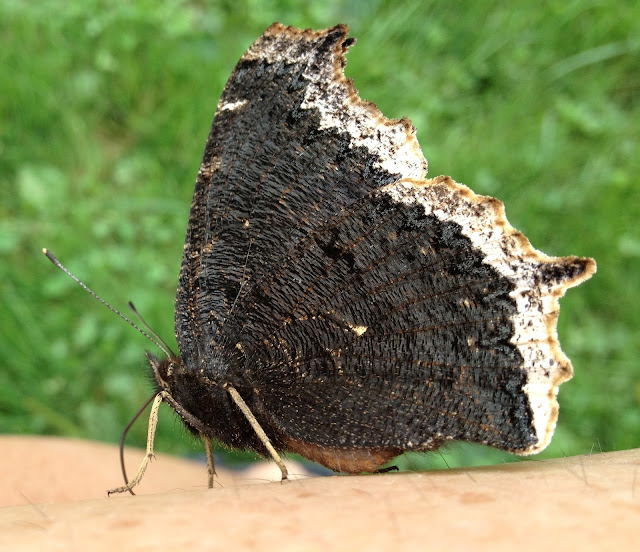I have butterflies. Not in my stomach, but in our yard. Yesterday, as I clipped the fading zinnia flowers, a monarch floated above the flower bed, landing on one zinnia and then another to probe for nectar. This was a fourth generation monarch. Its wings looked fresh and beautiful, delicate but sturdy enough to carry it all the way to its wintering grounds in Mexico.
Peak migration time for monarchs at our latitude (43N) is now--September 3rd to the 13th. As this fourth generation of monarchs gets ready for its long migration, it feeds on nectar-producing plants in meadows, field edges, roadsides, and yards. Many people maintain meadows and fields, not for hay, but for their scenic and habitat qualities. For these landowners, I suggest waiting until after mid-September for the annual mowing. This ensures that monarchs have sufficient nectar plants during their peak migration.
Two wonderful websites provide more cool information about monarchs--Monarch Watch and the Monarch Butterfly Website.
As I stood watching the monarch among the zinnias, another butterfly landed on my leg. This was another remarkable butterfly, the mourning cloak.
The mourning cloak adults emerge in June and July and then take a nap (they "aestivate"), before re-emerging again in the fall. This particular visitor to my leg looked fresh, like it just emerged from is month-long nap. It stayed on my leg for more than a minute, while I watched it probe my leg in search of sap. Mourning cloaks feed on sap, especially on oaks. Perhaps this one had really just emerged and was still getting its wings in order.
Most mourning cloaks overwinter here as adults, emerging in spring to lay eggs and then die. Their color patterns provides camouflage as they aestivate and overwinter under wood piles, in hollow logs, and under tree bark.
Meanwhile, a "flock" of cabbage white butterflies flitted among the flower beds and in the vegetable patch in the front yard. This is one of the few well-established, introduced butterflies in our region. The next butterfly to visit the zinnias was a painted lady. I think she was on her way to the southern U.S. to spend the winter.
Later in the afternoon as I sat on the deck overlooking the zinnias, I spotted a large bug. I knelt down to get a closer look at this creature sitting quietly on the deck and realized it was a cicada, indeed a true bug.
When I asked my friend Scott Young if he knew what species of cicada this might be, he replied that these bugs are difficult to identify. We think it is in the genus, Tibicen, which are the annual or dog-day cicadas. So named, because they emerge during the "dog days" of July and August. This cicada was as fresh-looking as the butterflies, although a little more bizarre with its giant eyes, green thorax, and large, well-veined wings. It let me take a few pictures before buzzing off to a tree.
Yesterday was a good day to sit or stand quietly outside as insects of all stripes emerged to feed and get ready for migration or winter, as the case may be.
Subscribe to:
Post Comments (Atom)
First Walks of 2024
We rise early, well before sunrise. It helps to go to bed early. Fortunately the New Year's Eve celebratory fireworks in the neighborhoo...

-
The oldest known hardwood tree in North America--at 700 years old--is a black gum tree tucked away in a hummocky swamp in southern New Hamps...
-
On Sunday I brought home a fragment of an animal skeleton from Seapoint Beach. At first it looked like a baby dragon, but that's just to...
-
We rise early, well before sunrise. It helps to go to bed early. Fortunately the New Year's Eve celebratory fireworks in the neighborhoo...










A wonderful posting that's chockfull of information and beautiful photos. (Your photo of the Mourning Cloak is outstanding!) It's been many years since I've encountered the term "aestivate", but surprised myself by immediately knowing what it is!
ReplyDeleteJohn
Thanks for the comments John! I was tickled when the mourning cloak landed on me and then stuck around. Have I mentioned that all the photos in my blog the last few months are with my iPhone using the 99 cent camera+ app. I am astonished that I can take relatively decent photos with it. Since my SLR died months ago I'd been trying to decided what to do about a camera. This cheap app is sufficing for now. It doesn't do movement or zoom at all well (pics are always fuzzy), but the macro is terrific and general landscape shots pretty good too.
ReplyDeleteEllen